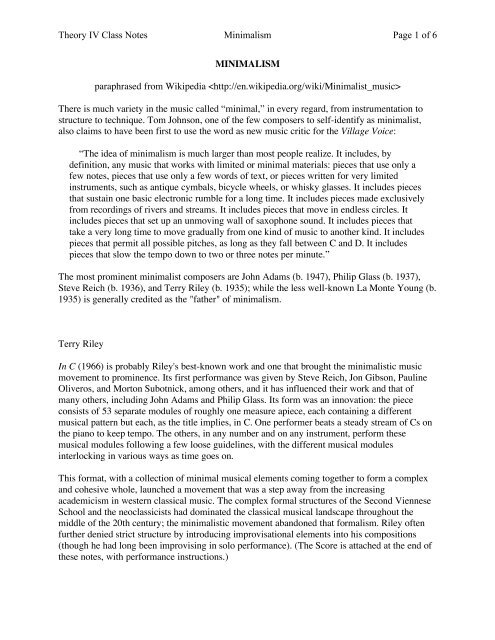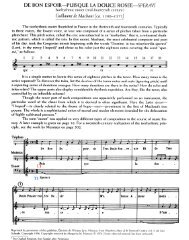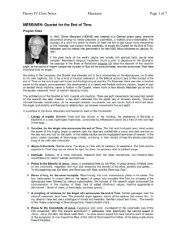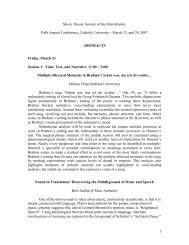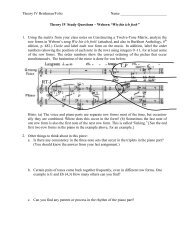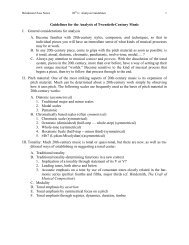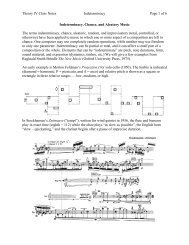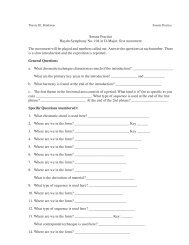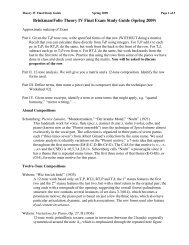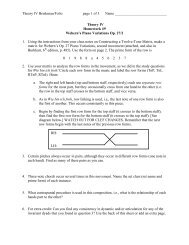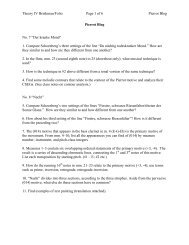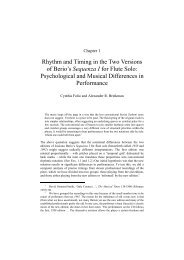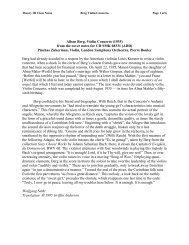Theory IV Class Notes Minimalism Page 1 of 6 MINIMALISM ...
Theory IV Class Notes Minimalism Page 1 of 6 MINIMALISM ...
Theory IV Class Notes Minimalism Page 1 of 6 MINIMALISM ...
Create successful ePaper yourself
Turn your PDF publications into a flip-book with our unique Google optimized e-Paper software.
<strong>Theory</strong> <strong>IV</strong> <strong>Class</strong> <strong>Notes</strong> <strong>Minimalism</strong> <strong>Page</strong> 1 <strong>of</strong> 6<br />
<strong>MINIMALISM</strong><br />
paraphrased from Wikipedia <br />
There is much variety in the music called “minimal,” in every regard, from instrumentation to<br />
structure to technique. Tom Johnson, one <strong>of</strong> the few composers to self-identify as minimalist,<br />
also claims to have been first to use the word as new music critic for the Village Voice:<br />
“The idea <strong>of</strong> minimalism is much larger than most people realize. It includes, by<br />
definition, any music that works with limited or minimal materials: pieces that use only a<br />
few notes, pieces that use only a few words <strong>of</strong> text, or pieces written for very limited<br />
instruments, such as antique cymbals, bicycle wheels, or whisky glasses. It includes pieces<br />
that sustain one basic electronic rumble for a long time. It includes pieces made exclusively<br />
from recordings <strong>of</strong> rivers and streams. It includes pieces that move in endless circles. It<br />
includes pieces that set up an unmoving wall <strong>of</strong> saxophone sound. It includes pieces that<br />
take a very long time to move gradually from one kind <strong>of</strong> music to another kind. It includes<br />
pieces that permit all possible pitches, as long as they fall between C and D. It includes<br />
pieces that slow the tempo down to two or three notes per minute.”<br />
The most prominent minimalist composers are John Adams (b. 1947), Philip Glass (b. 1937),<br />
Steve Reich (b. 1936), and Terry Riley (b. 1935); while the less well-known La Monte Young (b.<br />
1935) is generally credited as the "father" <strong>of</strong> minimalism.<br />
Terry Riley<br />
In C (1966) is probably Riley's best-known work and one that brought the minimalistic music<br />
movement to prominence. Its first performance was given by Steve Reich, Jon Gibson, Pauline<br />
Oliveros, and Morton Subotnick, among others, and it has influenced their work and that <strong>of</strong><br />
many others, including John Adams and Philip Glass. Its form was an innovation: the piece<br />
consists <strong>of</strong> 53 separate modules <strong>of</strong> roughly one measure apiece, each containing a different<br />
musical pattern but each, as the title implies, in C. One performer beats a steady stream <strong>of</strong> Cs on<br />
the piano to keep tempo. The others, in any number and on any instrument, perform these<br />
musical modules following a few loose guidelines, with the different musical modules<br />
interlocking in various ways as time goes on.<br />
This format, with a collection <strong>of</strong> minimal musical elements coming together to form a complex<br />
and cohesive whole, launched a movement that was a step away from the increasing<br />
academicism in western classical music. The complex formal structures <strong>of</strong> the Second Viennese<br />
School and the neoclassicists had dominated the classical musical landscape throughout the<br />
middle <strong>of</strong> the 20th century; the minimalistic movement abandoned that formalism. Riley <strong>of</strong>ten<br />
further denied strict structure by introducing improvisational elements into his compositions<br />
(though he had long been improvising in solo performance). (The Score is attached at the end <strong>of</strong><br />
these notes, with performance instructions.)
<strong>Theory</strong> <strong>IV</strong> <strong>Class</strong> <strong>Notes</strong> <strong>Minimalism</strong> <strong>Page</strong> 2 <strong>of</strong> 6<br />
Steve Reich<br />
Steve Reich’s Violin Phase (1967) is an example <strong>of</strong> PHASE MUSIC, a sub-category <strong>of</strong><br />
PROCESS MUSIC, which is itself a particular kind <strong>of</strong> <strong>MINIMALISM</strong>:<br />
<strong>MINIMALISM</strong> ==> PROCESS MUSIC ==> PHASE MUSIC<br />
From the liner notes by Steve Reich:<br />
“In Violin Phase the performer plays against one, then two, and finally three pre-recorded tape<br />
tracks <strong>of</strong> himself. All the gradual shifts <strong>of</strong> phase are accomplished by the performer moving<br />
slowly ahead <strong>of</strong> the stationary tape. In two sections <strong>of</strong> the piece the performer plays several <strong>of</strong><br />
the pre-existing patterns created by the interlocking <strong>of</strong> the same pattern against itself in different<br />
rhythmic positions. These resulting patterns are faded in until they are a bit louder than the tape<br />
and then are gradually faded out, leaving the listener momentarily more aware <strong>of</strong> that particular<br />
pattern. The choice <strong>of</strong> these patterns (there are many <strong>of</strong> them) is largely up to the performer, and<br />
I would like to thank Shem Guibbory for finding several very musical ones.” [excerpt on p. 4]<br />
Reich constructed Come Out (1966) from a recorded voice played in and out <strong>of</strong> phase. A single<br />
spoken line given by an injured survivor <strong>of</strong> a race riot is manipulated. The survivor, who had<br />
been beaten, punctured a bruise on his own body to convince police about his beating. The<br />
spoken line includes the phrase “to let the bruise blood come out to show them.” Reich<br />
rerecorded the fragment "come out to show them" on two channels, which are initially played in<br />
unison. They quickly slip out <strong>of</strong> sync; gradually the discrepancy widens and becomes a<br />
reverberation. The two voices then split into four, looped continuously, then eight, and continues<br />
splitting until the actual words are unintelligible, leaving the listener with only the rhythmic and<br />
tonal patterns <strong>of</strong> speech.<br />
Clapping Music (1972) was the last (and simplest) <strong>of</strong> Reich’s strictly “phase” compositions. It<br />
consists <strong>of</strong> a one-measure rhythmic pattern, twelve eighth-notes in length. The first performer<br />
keeps repeating the pattern. The second performer begins in sync with the first, and then in each<br />
successive measure “rotates” the pattern, beginning with the second duration, then the third, etc.,<br />
until the performers are back in sync at the end. Each measure is played twelve times.<br />
Philip Glass<br />
Koyaanisqatsi (1983), Hopi Indian for “Life out <strong>of</strong> balance,” is a documentary film directed by<br />
Godfrey Reggio with music composed by minimalist composer Philip Glass and cinematography<br />
by Ron Fricke. The film consists mostly <strong>of</strong> slow motion and time-lapse photography. The<br />
documentary contains no narration and relies heavily on music to set the film's tone.<br />
The film is the first in the Qatsi trilogy <strong>of</strong> films, including the films Powaqqatsi and Naqoyqatsi.<br />
The trilogy depicts different aspects <strong>of</strong> man and technology. Due to copyright issues, the film<br />
was out-<strong>of</strong>-print for over a decade. Glass and his Philip Glass Ensemble have toured with the<br />
film, playing the music live in front <strong>of</strong> the film screen.
<strong>Theory</strong> <strong>IV</strong> <strong>Class</strong> <strong>Notes</strong> <strong>Minimalism</strong> <strong>Page</strong> 3 <strong>of</strong> 6<br />
Terry Riley’s In C. The composer’s performance directions are listed below. The score is on the<br />
following page.
<strong>Theory</strong> <strong>IV</strong> <strong>Class</strong> <strong>Notes</strong> <strong>Minimalism</strong> <strong>Page</strong> 4 <strong>of</strong> 6<br />
Terry Riley: IN C
<strong>Theory</strong> <strong>IV</strong> <strong>Class</strong> <strong>Notes</strong> <strong>Minimalism</strong> <strong>Page</strong> 5 <strong>of</strong> 6<br />
The first page <strong>of</strong> Reich’s “Violin Phase” is shown on the next page. The complete score is in<br />
your anthology.
<strong>Theory</strong> <strong>IV</strong> <strong>Class</strong> <strong>Notes</strong> <strong>Minimalism</strong> <strong>Page</strong> 6 <strong>of</strong> 6


